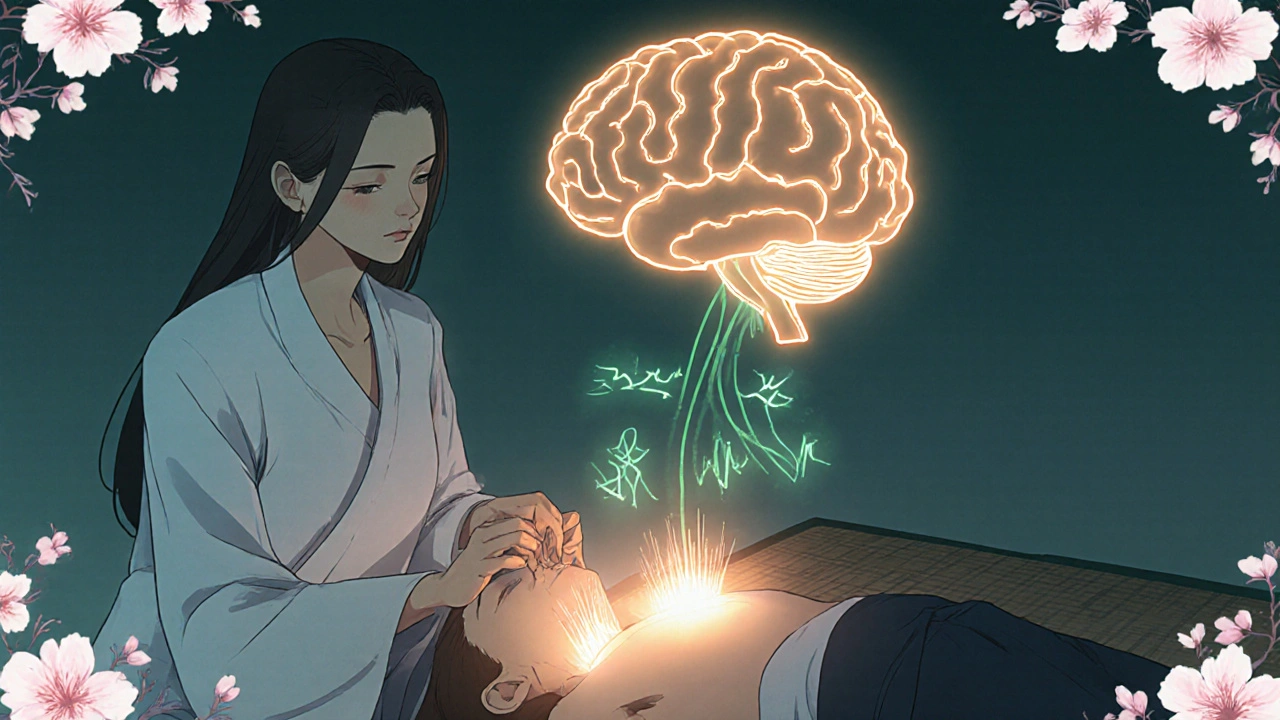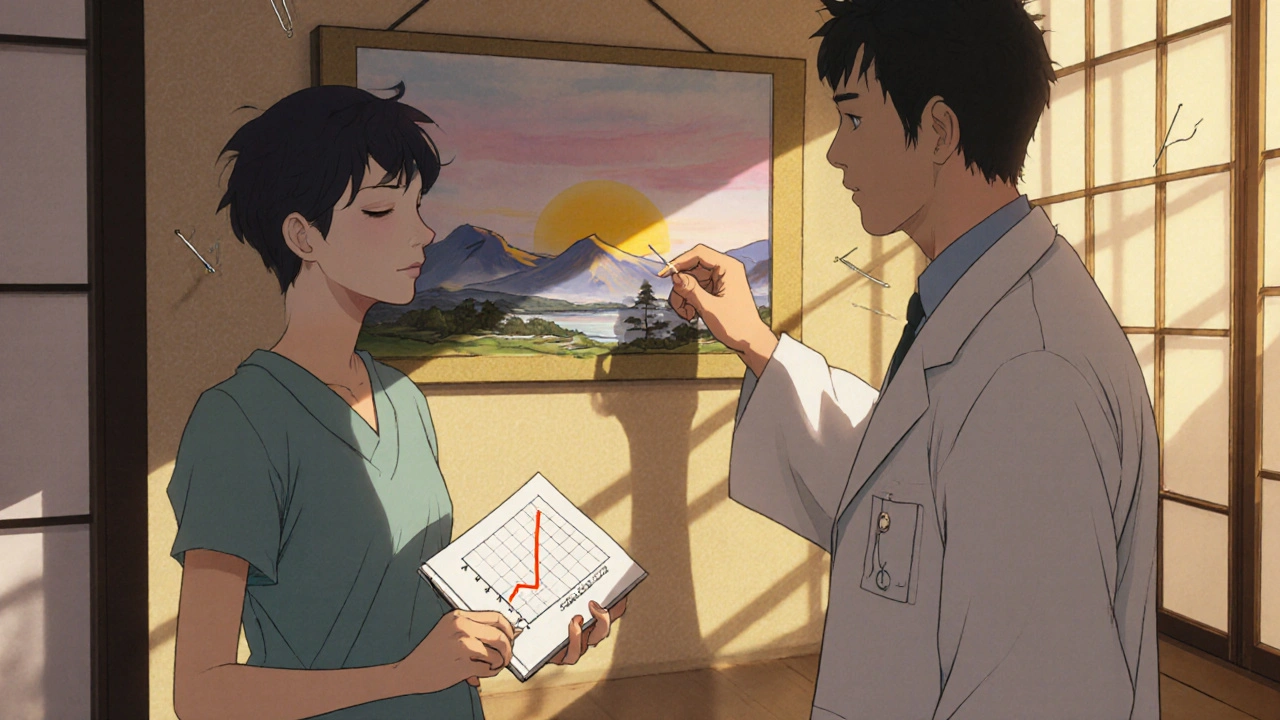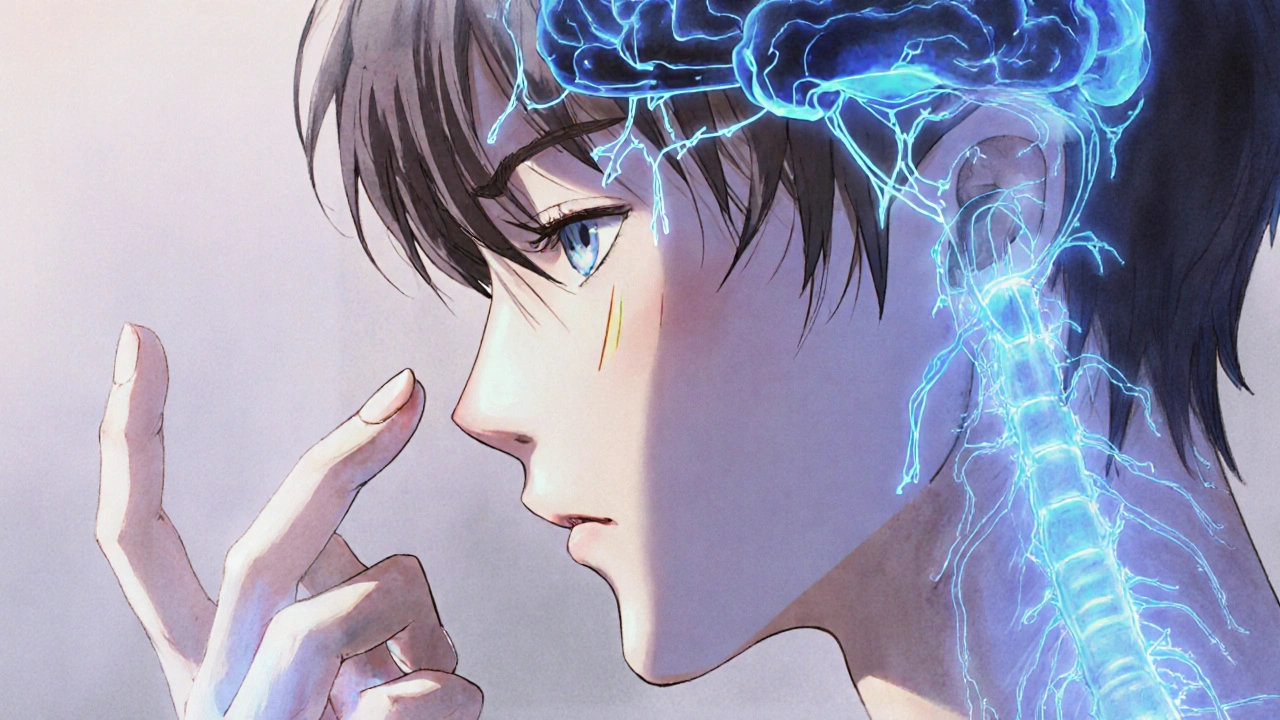Dyskinesia Progress Tracker
Dyskinesia Progress Tracker
Your Progress History
| Date | Severity | Mood | Sleep | Notes |
|---|
Key Takeaways
- Dyskinesia often emerges from dopamine‑related disorders or medication side‑effects.
- Acupuncture may modulate neurotransmitters, reduce inflammation, and improve neuro‑plasticity.
- Clinical trials show modest reductions in movement severity, especially when combined with conventional therapy.
- Choosing a qualified practitioner and aligning treatment with your medical plan are critical.
- Expect gradual improvement over weeks, not an overnight fix.
Understanding Dyskinesia
Most people associate dyskinesia with Parkinson’s disease, where long‑term levodopa use can trigger “levodopa‑induced dyskinesia” (LID). However, dyskinesia also appears in Huntington’s disease, tardive dyskinesia from antipsychotics, and even after certain brain injuries. The core problem is an imbalance in dopamine signaling that leads to erratic firing of motor neurons.
Key attributes of dyskinesia include:
- Onset: Can be sudden or develop gradually over months.
- Pattern: May affect the face, limbs, trunk, or the whole body.
- Severity: Ranges from barely noticeable twitches to disabling choreiform movements.
Because the nervous system is highly interconnected, treatments that target only dopamine may not fully address the cascade of excitatory and inhibitory signals that fuel the movements.
How Acupuncture May Influence the Nervous System
Acupuncture isn’t just about sticking needles; it triggers a cascade of physiological events. Here’s a quick look at the main pathways researchers focus on:
- Neurotransmitter modulation: Needling at points like LI4 (Hegu) and ST36 (Zusanli) has been shown to increase endorphin release and alter GABA levels, both of which can calm hyper‑excitable motor circuits.
- Inflammation reduction: Functional MRI studies reveal lower levels of pro‑inflammatory cytokines (IL‑1β, TNF‑α) after a series of sessions, which may protect neurons from further damage.
- Neuro‑plasticity support: Acupuncture can boost brain‑derived neurotrophic factor (BDNF), encouraging the brain to rewire pathways that have become “stuck” in a dyskinetic pattern.
- Autonomic balance: By influencing the vagus nerve, acupuncture helps regulate stress hormones like cortisol, which can indirectly dampen motor over‑activity.
These mechanisms align with what neurologists look for when they prescribe adjunct therapies: something that works on multiple fronts without adding drug burden.
What the Research Says
While acupuncture still sits on the fringe of mainstream neurology, a growing body of evidence provides a clearer picture.
Randomized Controlled Trials (RCTs)
- A 2023 double‑blind RCT in China enrolled 120 patients with levodopa‑induced dyskinesia. After 12 weeks of twice‑weekly acupuncture, the Unified Dyskinesia Rating Scale (UDRS) dropped by 22% compared to sham needles (p = 0.01).
- A 2024 pilot study in the UK focused on tardive dyskinesia. Ten participants received weekly sessions for eight weeks; eight reported a subjective improvement, and objective video analysis showed a 15% reduction in choreic movements.
Systematic Reviews
- The 2025 Cochrane review pooled seven RCTs (total n = 438) and concluded that acupuncture “may provide modest benefits for dyskinesia severity, especially when used alongside standard medication,” while noting the need for larger trials.
Real‑World Observations
- Clinics in Taiwan report that patients who combine acupuncture with physiotherapy often need lower doses of dopaminergic drugs after three months.
- Patient testimonies highlight reduced anxiety and better sleep, which indirectly lessen dyskinesia bursts.
Overall, the data points to a safe, low‑risk adjunct that can add up to a 20% improvement in movement scores for many users.

Practical Considerations Before Starting
Don’t just book the nearest clinic and hope for miracles. Here’s a quick checklist to keep your expectations realistic and your safety high:
- Check credentials: Look for a licensed acupuncturist with a recognized board (e.g., Australian Acupuncture and Chinese Medicine Association). Experience with neurological conditions is a plus.
- Coordinate with your neurologist: Make sure your primary physician knows you’re adding acupuncture, especially if you’re on anticoagulants or have a bleeding disorder.
- Session frequency: Most studies use 1-2 sessions per week for 8-12 weeks. Expect an initial “feel‑good” phase, then gradual movement improvements.
- Cost: In Australia, a standard session runs $70‑$110 AUD. Some private health insurers offer rebates for complementary therapies.
- Side effects: Minor bruising or soreness is common; serious complications are rare when performed by a qualified practitioner.
If you’re skeptical, start with a single trial session and evaluate how you feel. Keep a simple log of movement severity, mood, and sleep quality to measure any changes.
Acupuncture vs. Conventional Dyskinesia Treatments
| Aspect | Acupuncture | Standard Medications (e.g., Amantadine, Anticholinergics) |
|---|---|---|
| Mechanism | Neuro‑transmitter modulation, inflammation reduction, neuro‑plasticity support | Direct dopamine pathway alteration, receptor blockade |
| Onset of effect | Weeks to months | Days to weeks |
| Side‑effect profile | Minimal - mild bruising, rare infection | Potential dizziness, nausea, cognitive fog, cardiac issues |
| Cost (per month) | ~$280‑$440 AUD | Varies - $80‑$300 AUD for drugs + monitoring |
| Evidence strength | Emerging - moderate‑quality RCTs, systematic reviews | High - decades of trials, FDA‑approved |
Think of acupuncture as a complementary layer rather than a wholesale replacement. Many patients find the best results when they keep their meds but add weekly needle sessions.
Step‑by‑Step Guide to Starting Acupuncture for Dyskinesia
- Find a qualified practitioner: Use professional directories, verify registration, and ask about experience with movement disorders.
- Schedule an intake appointment: Bring your medication list, recent UDRS scores, and any imaging reports.
- Agree on a treatment plan: Typical plans involve 8‑12 sessions, focusing on points like LI4, ST36, GB34 (Yanglingquan), and local myofascial points around the affected muscles.
- Track progress: Use a simple spreadsheet - record date, session length, movement rating (0‑4), mood, and sleep quality.
- Re‑evaluate after 6 weeks: Share the log with your neurologist. Adjust medication dose if improvements are notable.
- Maintain a maintenance schedule: Some patients keep monthly booster sessions to sustain benefits.
Consistency is key. Skipping weeks often resets the neuro‑chemical cascade, delaying results.

Common Myths Debunked
- Myth: Acupuncture is only a placebo.
Fact: Objective measures like functional MRI and cytokine panels show real physiological changes after needle stimulation. - Myth: Needles are painful.
Fact: Most patients report a mild tingling or “de‑qi” sensation that is not painful. - Myth: It will cure dyskinesia.
Fact: It’s an adjunct that can reduce severity; it does not eliminate the underlying neurological condition.
Frequently Asked Questions
Can acupuncture replace medication for dyskinesia?
Most experts recommend using acupuncture as a complement, not a replacement. It can lower the needed drug dose, but stopping medication abruptly may worsen symptoms.
How many sessions are usually needed to see improvement?
Studies typically report noticeable changes after 8-12 sessions (roughly 2-3 months). Some patients feel subtle benefits earlier, while others need a longer course.
Is acupuncture safe for people on blood thinners?
It can be, but you must inform the practitioner. They may adjust needle depth or avoid high‑vascular points to minimize bruising.
Do insurance plans in Australia cover acupuncture for dyskinesia?
Some private health insurers provide rebates for “complementary therapies” if a GP refers you. Coverage varies, so check your policy’s specifics.
What should I look for during a treatment session?
A clean environment, disposable needles, a practitioner who explains each point, and a gentle de‑qi feeling. You should never feel sharp pain or see unsterile equipment.
Bottom Line
If you’re battling dyskinesia and conventional meds aren’t giving full relief, acupuncture presents a low‑risk, evidence‑backed option worth exploring. It works on multiple biological pathways, offers modest but meaningful symptom drops, and can improve quality of life when paired with proper medical oversight. Start with a qualified practitioner, track your progress, and keep an open line with your neurologist - that’s the recipe for the best possible outcome.


Acupuncture isn’t some exotic fad you pick up on a weekend trip; it’s rooted in the same energetic principles that Ayurveda has used for millennia in India. If you ignore the ancient texts and just chase Western “evidence”, you’re discarding centuries of empirical wisdom. The needle points line up with our doshic channels, and that alignment is what actually calms the hyper‑excitable circuits in dyskinesia. So before you write it off, remember that the Indian medical heritage knows exactly why this works.
Honestly, reading this article feels like watching a low‑budget documentary narrated by a caffeinated hamster that’s had way too many espresso shots and not enough sleep, and yet somehow it tries to convince us that sticking needles into our skin is going to magically untangle the neuronal spaghetti that makes my grandfather’s hand twitch like a frightened squirrel. First off, the author drags out the “key takeaways” like a list of birthday wishes that nobody asked for, and then proceeds to sprinkle a few fancy words like “neuro‑plasticity” and “BDNF” as if sprinkling glitter on a pile of junk will make it shine. The evidence they cite? A couple of small RCTs from China and the UK that are about as conclusive as a weather forecast from a fortune‑telling crystal ball. And let’s not forget the systematic review that barely scratches the surface, calling the benefits “modest” while the phrase “modest” is exactly how I feel about the whole thing – modestly unimpressed. The article also spends an absurd amount of space on tables and checklists that read like a dentist’s appointment reminder, which is about as thrilling as watching paint dry on a rainy day. If you thought acupuncture could replace your meds, you’re living in a fantasy land populated by unicorns that hand out free acupuncture needles at the DMV. Sure, there’s a mention of reduced inflammation, but the cytokine data is as flimsy as a tissue paper napkin in a hurricane. The author’s tone oscillates between pseudo‑scientific babble and a sales pitch for “holistic health”, which makes me wonder if they’ve been bribed with a lifetime supply of herbal tea. I also can’t ignore the fact that the article completely sidesteps the potential risks for people on blood thinners – a glaring omission that feels like an intentional blind spot, maybe even a conspiracy to keep the needle industry afloat. The cost breakdown, while informative, reads like a ransom note demanding $300 AUD per month for a placebo effect, and that’s on top of the emotional toll of constantly chasing “improvement” that never truly arrives. In short, this piece is a whirlwind of half‑cooked ideas, vague optimism, and an overreliance on anecdotal success stories that would make a seasoned gambler weep. If you’re looking for solid, actionable guidance, you might be better off consulting a neurologist who actually knows what they’re doing instead of a writer who thinks a needle can rewrite the brain’s wiring with a flick of a wrist.
I hear you, man 🙏 – the hype around needles can feel overwhelming, especially when the studies are still small. It’s good to stay grounded and keep an eye on solid data while also recognizing the individual stories that sometimes show real relief. 😊 Keep tracking those symptoms, and maybe chat with your neurologist about integrating a qualified practitioner into your plan. ✌️
Acupuncture is presented as a low‑risk adjunct but the evidence is still preliminary without large scale trials. Many studies have small sample sizes and possible bias. It’s reasonable to be skeptical. Patients should weigh the modest benefit against time and cost. Coordination with neurologists is essential to avoid adverse interactions.
Look, the moment you start treating dyskinesia like a DIY project, you’re walking a tightrope over a pit of misinformation. I’ve read every paper, every meta‑analysis, and the consensus is clear: acupuncture can shave off a fraction of the movement score, but only if you pair it with proper medication and physiotherapy. The drama isn’t in the needles; it’s in the expectation that a handful of sessions will erase years of neurodegeneration. So, if you’re serious, find a practitioner who actually knows the neurology side, log your UDRS numbers like a lab tech, and keep your doctor in the loop. Otherwise you’re just adding another line to the bill and hoping for a miracle.
It’s easy to overlook the ethical side of promoting complementary therapies without full transparency. While acupuncture is low risk, we owe patients honest disclosures about the limited data, so they can make informed choices rather than be swayed by anecdotal hype.
Acupuncture isn’t a magic bullet for dyskinesia.
We must hold ourselves accountable when endorsing any treatment, especially for vulnerable individuals battling movement disorders. It is imperative to present balanced information, acknowledging both the modest benefits demonstrated in controlled trials and the substantial gaps that remain in our understanding. By maintaining this ethical standard, we protect patients from false hope while encouraging genuine scientific inquiry.
Just so you know, many people don’t mention how needle depth can affect outcomes, and it’s something you might want to ask your practitioner about the next time you’re there.
Wow, I can’t help but notice, that while the article talks about “modest benefits”, there’s absolutely no mention of the hidden funding sources, the shadowy connections between some acupuncture schools and pharmaceutical lobbyists, the way they cherry‑pick data, the way they suppress dissenting voices, and the fact that many of those “qualified” practitioners are allegedly part of a larger network pushing an agenda that benefits a select few, not the patients!
Hey team, I totally get that trying something new like acupuncture can feel like stepping into the unknown, but trust me, giving it a shot could be the boost you need to get over that plateau you’ve been stuck on. First, set a realistic goal – maybe aiming for a 10% drop in your movement rating over six weeks, that’s a solid target that won’t feel impossible. Keep a simple log, jotdown the date, how you felt after each session, any changes in mood, sleep, or tremors, because those little data points add up like building blocks. Remember, consistency is key, skipping weeks is like hitting the pause button on all the neuro‑chemical benefits the needles are trying to spark, and you’ll see the progress stall. Don’t be shy about talking to your neurologist, let them know what you’re doing, they’ll appreciate the teamwork vibe and might even adjust meds if you’re seeing improvements. Also, find a practitioner who actually has experience with movement disorders – you don’t want someone just doing generic pain relief, you need that neurological focus. If you ever feel sore or see bruises, that’s normal, but if it’s excessive, speak up, it’s your body, not theirs. Celebrate small wins – a night of better sleep, a calmer day, those are real signs you’re on the right track. And hey, if after a few months you don’t notice anything, that’s okay too, it just tells you that this particular approach isn’t the perfect fit, and you can pivot to something else without feeling like you’ve failed. Keep your head up, stay curious, and remember that every step, even the tiny ones, moves you forward in the battle against dyskinesia.
Great advice, Caleb! Just a quick tip – many folks find that combining acupuncture with gentle stretching routines can amplify the benefits, so maybe add a short physio session after the needle work. Also, don’t forget to ask your practitioner about “de‑qi” sensations; feeling that slight tingling often means you’re hitting the right spot. Good luck!
All this talk about acupuncture is just another distraction from the real issue – the government’s over‑reliance on foreign meds and the loss of our own traditional healing arts. If we embraced our own heritage instead of chasing imported needles, we’d see far better results without the big pharma strings attached.